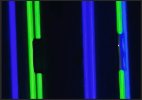MonkeeSage
Senior Member
Found a couple of interesting videos on their youtube channel.They seem to be using a Laser Space Canon, possibly by Phantom Dynamics? The company at SWR, New Salt lighting has Laser Space Canons as an option for setup.
The beginning of this one shows the Laser Space Cannon can be pulsed on and off.
Frame when pulsed on:
Frame when pulsed off:
Source: www.youtube.com/watch?v=sN016EhddEE
This one shows a studio laser show with different lasers, but showing they know how to cause "banding" where parts of the lasers appear invisible. (Don't know if "banding" is the right term but it's what the video description calls it.)
Source: www.youtube.com/watch?v=JZWYQO4JENY
NB. The spelling of the company name is actually Nu-Salt Laser Light Shows International. They have a teaser trailer for a previous episode of SWR they worked on showing a Laser space Cannon, so definitely the same company.
Source: www.youtube.com/watch?v=L5tMatBmu4M



